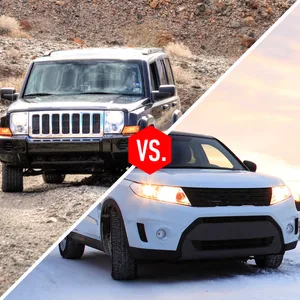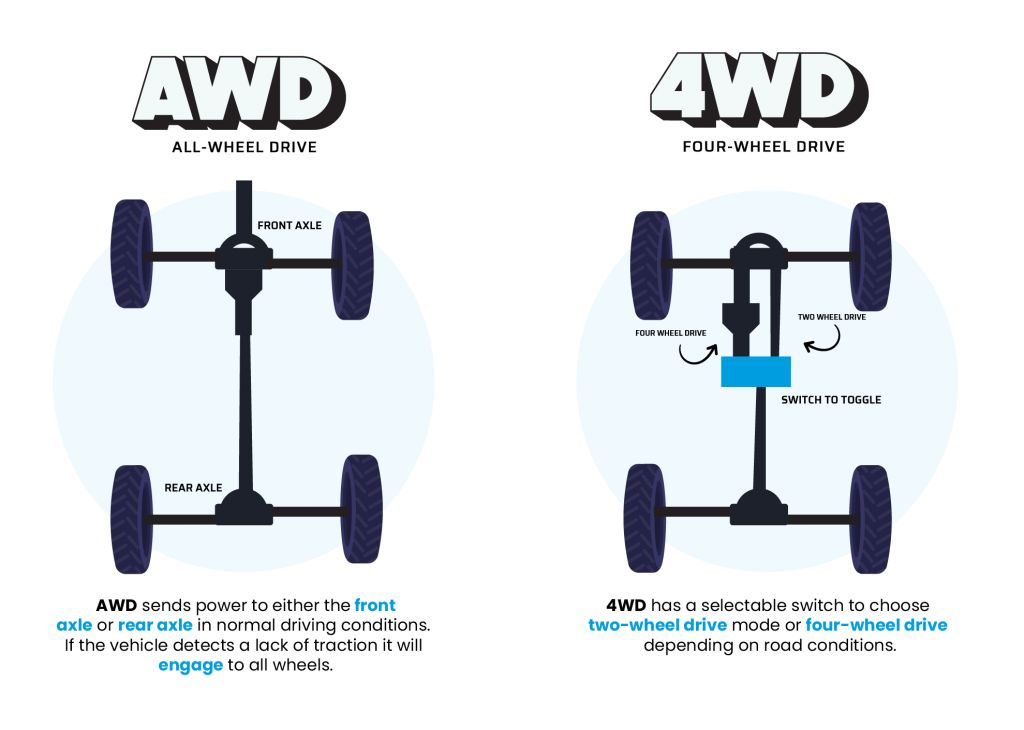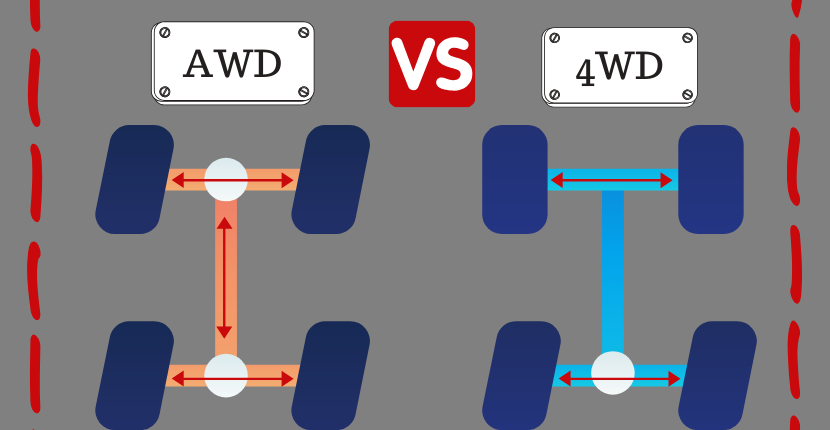When it comes to vehicle drivetrains, 4-wheel drive (4WD) and all-wheel drive (AWD) are two of the most commonly misunderstood terms. While both systems send power to all four wheels, they function differently and serve different driving needs.
So, how do you know which one is best for you? Whether you’re looking to conquer off-road trails, tackle snowy roads, or just get extra traction in rainy conditions, understanding the differences between 4WD and AWD can help you make the right choice.
Let’s break it down and compare how they work, where they’re used, and which system best suits your lifestyle.

What Is 4-Wheel Drive (4WD)?
4-wheel drive (4WD) is a rugged drivetrain system designed for off-road performance and extreme conditions. It provides equal power to all four wheels, helping vehicles navigate mud, sand, snow, and rocky terrains with maximum traction.
How 4WD Works
- 4WD systems use a transfer case that splits power evenly between the front and rear axles, ensuring all four wheels spin at the same speed.
- Many 4WD systems allow drivers to switch between 2WD and 4WD, which helps improve fuel efficiency when extra traction isn’t needed.
- Some vehicles also include low-range gearing, which provides even more power to tackle steep hills and rough terrain.
When to Use 4WD
- Off-roading: If you’re driving through dirt trails, rocky landscapes, or sand dunes, 4WD is the best choice.
- Heavy snow and deep mud: It provides the necessary grip to avoid getting stuck in challenging conditions.
- Steep inclines and declines: The even power distribution gives you better control when climbing or descending rugged slopes.
Common Vehicles with 4WD
You’ll typically find 4WD systems in trucks, SUVs, and specialized off-road vehicles. Some of the most popular 4WD-equipped vehicles include:
✔ Jeep Wrangler
✔ Toyota Land Cruiser
✔ Ford Bronco
✔ Chevrolet Silverado Z71
What Is All-Wheel Drive (AWD)?
All-wheel drive (AWD) is a smarter, automated drivetrain system that provides power to all four wheels as needed. Unlike 4WD, AWD is designed for on-road stability rather than extreme off-road use.
How AWD Works
- AWD monitors wheel traction and automatically adjusts power distribution between the front and rear wheels.
- It works full-time, meaning there’s no need for the driver to engage or disengage it.
- Many AWD systems use torque vectoring, which can send more power to individual wheels that need extra grip.

When to Use AWD
- Rainy, icy, or snowy roads: AWD helps maintain stability and control in unpredictable weather conditions.
- Daily driving: If you mostly drive on paved roads but want extra grip when needed, AWD is ideal.
- Light off-roading: While not built for extreme terrains, AWD can handle gravel roads and mild trails.
Common Vehicles with AWD
AWD is commonly found in crossovers, sedans, and SUVs designed for everyday driving. Some popular AWD-equipped vehicles include:
✔ Subaru Outback
✔ Audi Quattro series
✔ Honda CR-V
✔ Volvo XC90

Key Differences Between 4WD and AWD
| Feature | 4WD | AWD |
|---|---|---|
| Traction Control | Best for extreme off-road conditions | Best for wet, icy, or slippery roads |
| Power Distribution | Even power to all wheels when engaged | Adjusts power as needed |
| Driver Control | Requires manual engagement in many vehicles | Fully automatic system |
| Terrain Suitability | Designed for off-roading, deep snow, and mud | Ideal for city streets, highways, and light off-roading |
| Fuel Efficiency | Generally lower due to weight and complexity | More fuel-efficient than 4WD |
| Common Vehicles | Trucks, off-road SUVs | Crossovers, sedans, and SUVs |
Fuel Economy: Which System Saves More Gas?
One of the biggest considerations when choosing between 4WD and AWD is fuel economy.
- 4WD vehicles tend to be heavier, require extra drivetrain components, and often burn more fuel because of the added weight and mechanical complexity.
- AWD is more fuel-efficient because it only sends power to all four wheels when needed, reducing unnecessary energy consumption.
If fuel economy is your top priority, AWD is the better choice. However, if you regularly drive off-road, the trade-off in fuel efficiency is worth it for the added capability of 4WD.
Which One Is Right for You?
Now that you know the differences between 4WD and AWD, how do you decide which one is best for your driving needs?
Choose 4WD If:
✔ You drive on rugged, off-road terrain (mountains, sand, or rocky landscapes).
✔ You frequently tow heavy loads and need extra power.
✔ You live in an area with harsh winters and deep snow.
✔ You enjoy off-roading, adventure trips, and extreme conditions.
Choose AWD If:
✔ You primarily drive on paved roads but want extra safety in bad weather.
✔ You live in a region with rain, occasional snow, or icy roads.
✔ You want better handling and stability for daily driving.
✔ You prefer a low-maintenance, fuel-efficient system.
Final Thoughts: AWD vs. 4WD – Which One Wins?
The choice between AWD and 4WD comes down to how and where you drive.
- If you need rugged off-road capability and superior traction, 4WD is the way to go.
- If you want enhanced stability and control for daily driving, AWD is the smarter choice.
Both systems have their advantages and drawbacks, so consider your driving habits, location, and vehicle needs before making a decision. Whichever you choose, having the right drivetrain can make all the difference when conditions get tough.